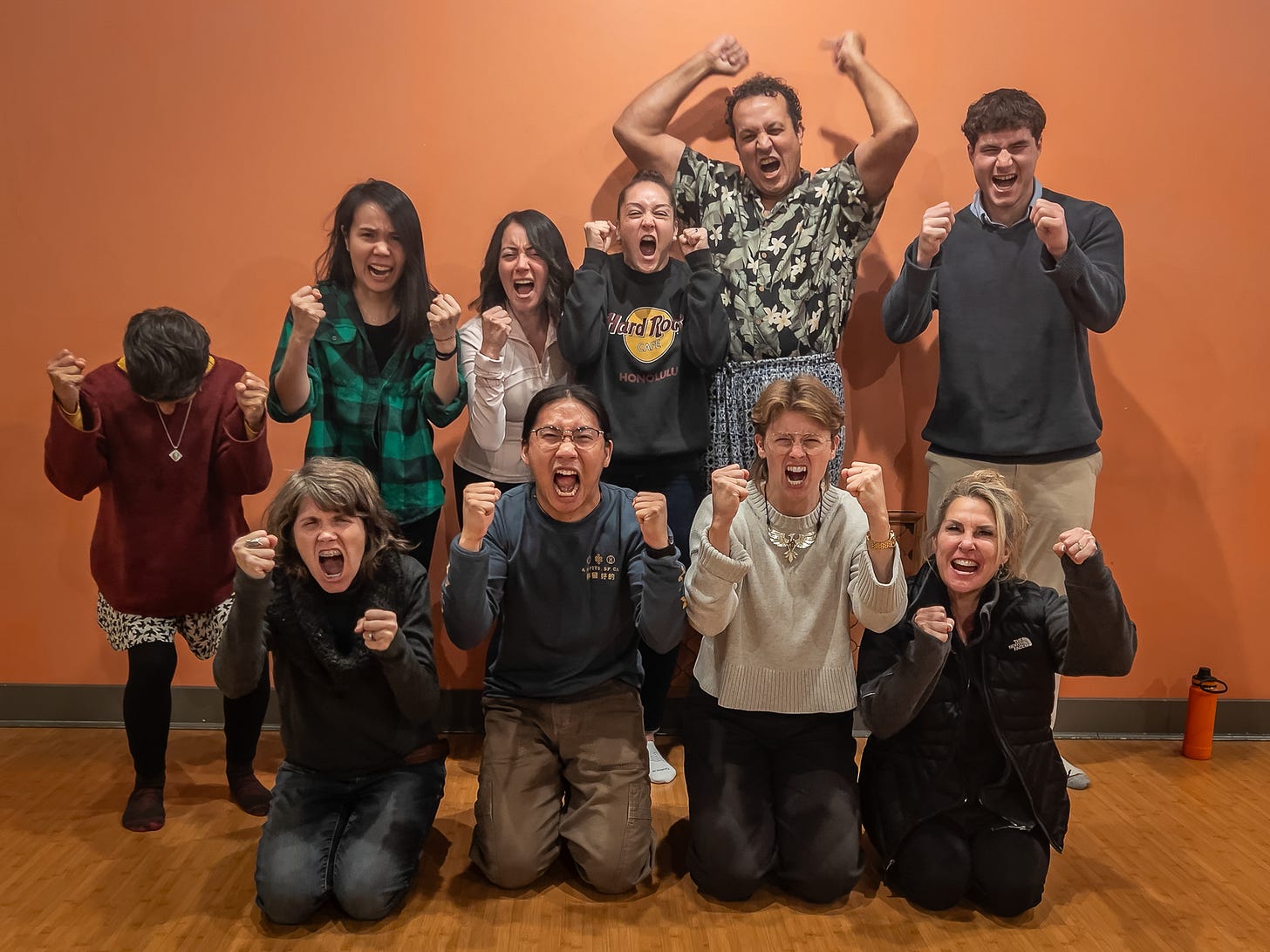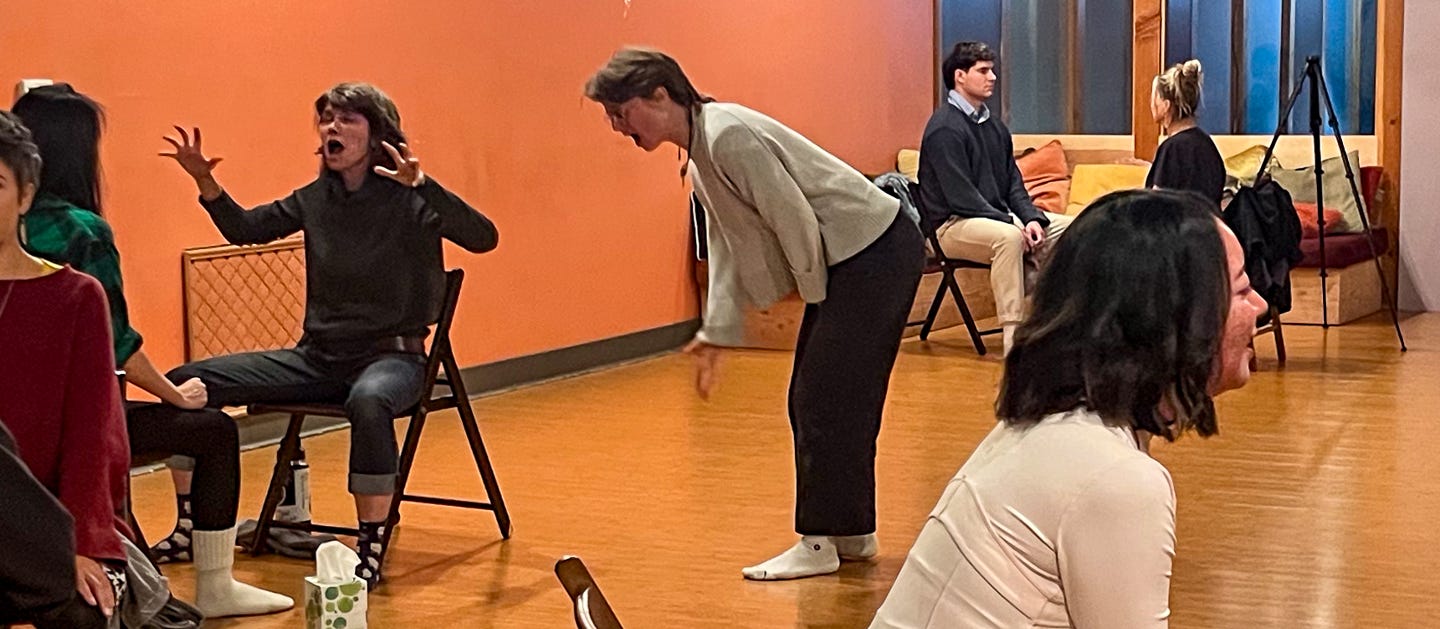What are you so mad about?
At Rage Club, anger is taboo no more
Have you ever had to suppress your anger because you think doing so would damage your reputation or hurt someone else’s feelings?
That’s where Rage Club comes in.
“Most of my life, people told me not to feel,” Rage Club co-facilitator Daway Chou-Ren said. “Don't cry, don't get angry, don't be afraid. Don't even be happy because that means you're not working hard enough. At a certain point, I just knew, I don't want my life to be like this. I want to be wilder, more free, more expressive.”
I participated in Rage Club last week at the Soft Medicine Sanctuary in Sebastopol. It was intense.
We started off by going around in a circle—there were about ten of us—to mention something we were angry about in the moment. Then we practiced looking into the eyes of someone across the circle and yelling, “No!” “Yes!” “No!” Many of us couldn’t help but smile and/or laugh, a phenomenon that we ended up dissecting as an entire group.
Next, we grabbed towels and twisted them as hard as we could while we yelled as hard as we could. After a few rounds, we held a brainstorming session about how to yell without blowing your voice box out. The key, Meredith Witt, the other co-facilitator said, is to have the sound come from your stomach rather than your throat.
While Chou-Ren and Witt pushed us to get as angry as we possibly could, they were also gracious considering that, for some of us, this was our first time getting so mad on purpose.
“It would be insane for someone to step onto a basketball court for the first time and expect to be perfect,” Meredith said. “It goes the same way for anger. In Rage Club we practice raising our anger and then lowering it back down to neutral. We do it on a team in a carefully held space so you can experiment and try new things out. That way the next time you're in a situation with someone you care about, or something stressful comes up, you have a choice about how you want to act. If you train your body to be used to holding and flowing anger, you will not be taken over by your anger. You can stay in connection and say what you need to say or be with someone who needs to communicate something.”
The thinking is that going to Rage Club is like getting vaccinated. You give yourself a little bit of the disease so that your body knows what it is and knows what to do with it. You give yourself a little bit of rage so that your body doesn’t fill up with it.
Perhaps the most fervid part of the evening came when we were separated off into pairs. Sitting across from our partner, we were told to take on the persona of someone in their own life that they were mad at. I was my partner’s ex-husband, for example, and she was told to let it rip. Who knew I could be such an asshole!
Then, in the second round, we were told to keep calmer and to use “conscious anger.”
We both had a hard time during this second round. I found it difficult because I felt like I used conscious anger in the first round and didn’t realize there would be a second round, and she found it difficult because she couldn’t think about her ex-husband without wanting to slap me in the face.
This exercise proved to be quite cathartic for many of the participants, including someone who was sobbing as she screamed at her abusive father (a white woman in her 30s) in Vietnamese. Boxes of tissues were scattered around the room.

Besides Rage Club, Witt and Chou-Ren hold other workshops about personal transformation, some of which are about reclaiming sexual energy, or about breaking out of crystallized identities and ego patterns.
This all comes from a line of work now known as “Possibility Management,” which follows the logic that by being aware of one’s emotions, one can choose how they want to show up in any given situation.
The possibilities are endless.
“We treat anger as a neutral source of information for living your life,” said Witt. “How you act on the information is your choice. When we practice feeling and expressing our anger, we get more choices for what to do the next time it happens.”
Rage Club will return to Soft Medicine in early 2025.
You can follow them on Instagram at @RageClubSF. And you can check out Witt’s work at meredithwitt.com and Chou-Ren’s work at dawaychouren.com




I think it would be much more practical and helpful to use the Connection Practice based on Heartmath and Nonviolent Communication than to manifest an emotion into expressing rage.
This reminds me of something we did back in the early 90’s called co-counseling. I partnered with a guy and we were at his house. There was a bowl of grapes on the table. He was telling me about his perfectionist mom and how she would trim the grape stems so that they always looked perfect. I threw a grape at him (gently) and we started throwing grapes at each other and across the kitchen. It was hilarious and really healing for him to have that emotional release.